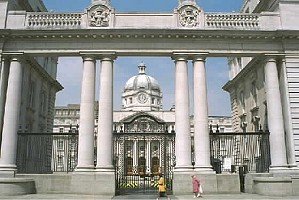How We Are Governed - Dáil
“The word democracy comes from two Greek words “demos” = people, “Kratia” = to rule”, Abraham Lincoln, President of the United States in 1863 said that democracy is “Government of the people, by the people for the people”, So all of us are the basis of democracy. It is our Constitution that gives us this right.
This is a Picture of our our present Constitution called
”Bunreacht na hEireann”.
The Constitution was adopted by the people in 1937.
The Oireachtas
People who vote are the foundation stone of the Government. It is they who elect the President and the members of the Dáil . This is a picture of Government Buildings where the Dáil and Seanad sit. These two bodies - the Dáil and the Seanad represent the way our system of Government is organised. This is called the Oireachtas.
This is Áras an Uachtaráin where the President of the country lives.
What do we know about the President of Ireland
- Elected for 7 years. Can be elected for a second term. Mary McAleese was recently elected for a second term of 7 years
- Is known as the first citizen.
- Represents Ireland abroad.
- Signs bills into law.
- Is Supreme Commander of the Defence Forces.
- Has to be over 35 years on first election.
There are 166 TDs in the Dáil.
- A party needs a majority to form the Government in Parliament (50% +1), a party must have 84 TDs elected to go into Government. When 2 parties form a Government, it is known as a Coalition Government.
- The Government in power is made up of the Cabinet, Ministers and Backbenchers. The Cabinet must have at least 7 and not more than 15 members. It must include the Tánaiste and the Taoiseach and the Minister for Finance.
- The Taoiseach is leader of the Government. S/he chairs the Cabinet meetings. S/he decides the time for a General Election, meets with leaders from other countries and selects 11 of the 60 Senators in the Seanad.
- The Tánaiste is like the vice captain of the team. S/he takes the place of the Taoiseach when s/he is absent.
- The Ministers are the leaders of the Government Departments.
The Main Business of Government:
- Care/Management of Public Finances
- Administration of Departments
- Legislation in economic, financial and social areas.
TDs represent all of the electorate in their own Constituency. Each TD provides the democratic link between the people and the Government. The TD’s main role is to pass laws and decide on policies that affect the lives of the people. For example after the Budget, TDs must vote on the Finance Bill which gives approval for any changes made by the Budget, such as increases in social welfare. TDs also have representative functions. They may represent the Government on various committees such as the V.E.C. Boards. A TD can make submissions on behalf of constituents to Ministers, Government Departments, etc.
Very often the TD sets aside a special time and place to hear the concerns of her/his constituents. These are called ‘clinics’ or ‘advice centres’. For example, a family may need help for a child in need of special assistance. They can visit the clinic and bring this matter to the attention of the local TD who can then use Dail procedures to have this item raised on the floor of the Dáil.
Dáil Procedures
Question Time: Every Tuesday, Wednesday and Thursday, Dáil Éireann sets aside a period of time commencing at 2.30 pm for Question Time. During this time a TD may ask questions of the Government on matters for which they are responsible. This is one of the most important procedures which TDs use to make the Government accountable to Dáil Eireann and through it, to the people. Questions must be prepared in advance and given to the Taoiseach or the Minister who is responsible for answering questions on any given day.
Sometimes, TDs will want to ask a question on a matter of great public importance which has come up suddenly. The Ceann Comhairle can accept such a question at very short notice. A question that comes up in an urgent way like this is known as a Private Notice Question and is taken at the end of Question Time.
Adjournment Debates
Another means of raising an issue is through a procedure called Adjournment Debates. At the end of each Dáil session, the Ceann Comhairle allows 4 members to raise matters of national or local concern. This is the Adjournment Debate
The Chief Whip must decide the order of business and make sure the Dáil gets through all the work it has to do.
Do you to know that?
- 51% of our population are women
- Only 13.8% of the elected members of the Dáil are women
- At the present rate, it will take 370 years for 50% of Dáil representatives to be women
